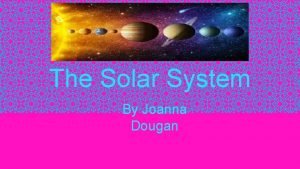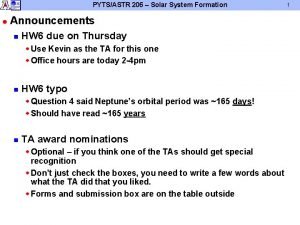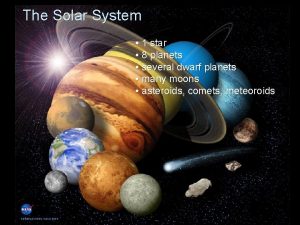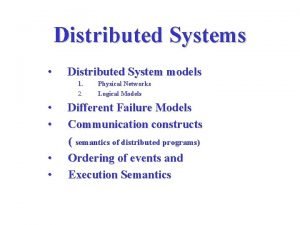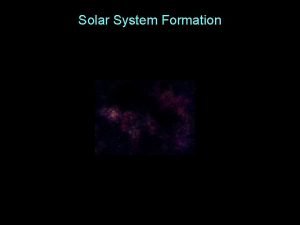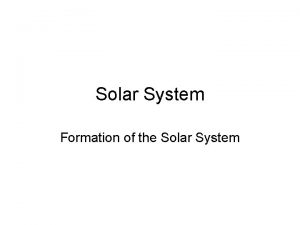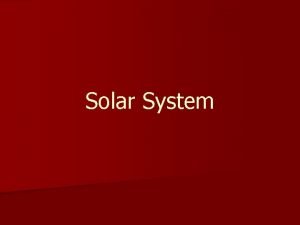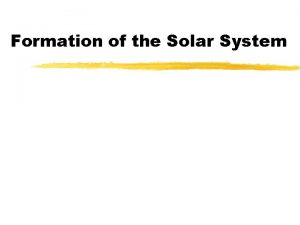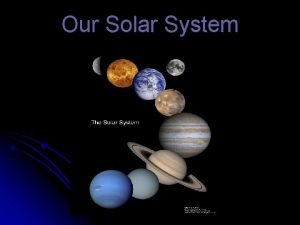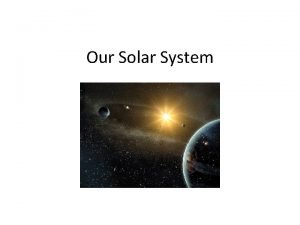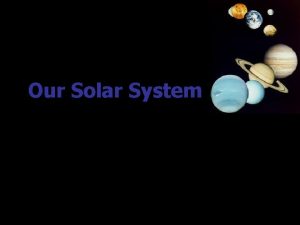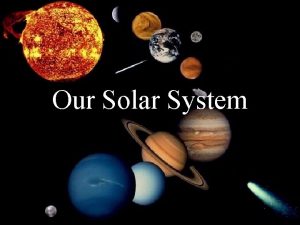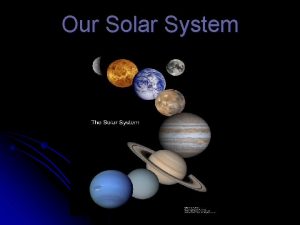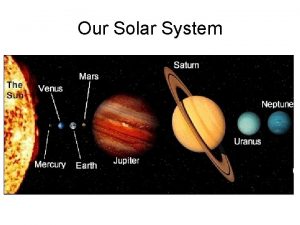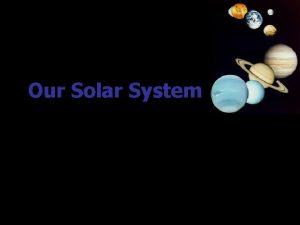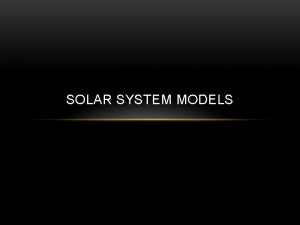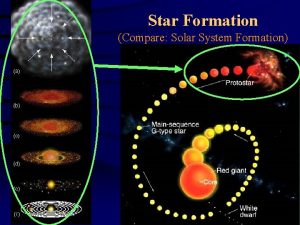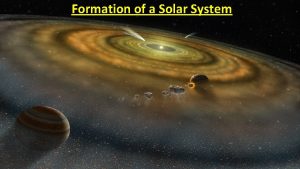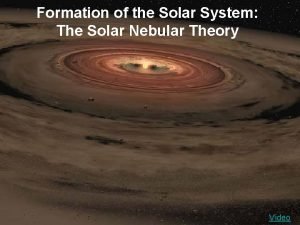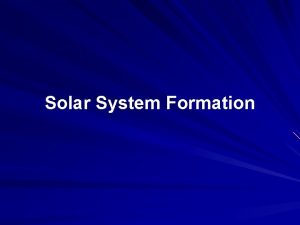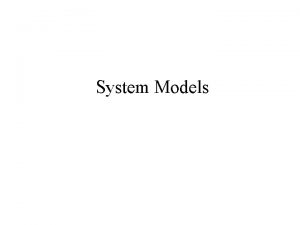Solar System Formation of the Solar System Models





























- Slides: 29

Solar System Formation of the Solar System

Models of the Solar System • There are two main models that have existed in history 1. Geocentric (Earthcentered) - also called the Ptolemy Model 2. Heliocentric (Suncentered) - also called the Copernicus Model

Geocentric Model • The first model put Earth in the center of the Solar System – Called the Geocentric Model – Everything in space revolved around the Earth – Proposed by many including the famous Greek philosopher, Aristotle, around 350 BC

Geocentric Model • In 140 AD, Ptolemy expanded Geocentric Model • Could describe and predict motion of the sun and planets • Used mathematics and little observation • Very complicated • Used for over 1000 years

Think! • What did Aristotle propose about the Solar System? • Define ‘geocentric’:

Heliocentric Model • Model with Sun in the center of the Solar System • In 1543, Nicolaus Copernicus moved the sun to the center. • Proposed the heliocentric model = “sun-centered” model • Was initially rejected by scientific community

New Ideas & Technology • In 1605, Johannes Kepler improved the model by proposing that the orbits around the sun are ellipses, or ovals, rather than circles. • In 1609, Galileo Galilei made a newer, better telescope – Key technology that allowed important observations to be made in support of the Heliocentric Model

Heliocentric Model is Improved Even More • In 1687, Sir Isaac Newton ties it all together • Explained that gravity keeps the planets in orbit around the sun, and satellites in orbit around planets. • BUT couldn’t explain why…

Think! • What did each of these scientists do or say to build on our knowledge of the Solar System: • Copernicus? • Kepler? • Newton?

Changing From Geocentric to Heliocentric Model • Ptolemy & Aristotle didn’t have the technology (telescope) to make good observations • Ptolemy could predict, but the model was very complicated • Copernicus, Kepler, Galileo, & Newton each contributed over time to the development of the Heliocentric Model


Formation of the Solar System • According to dating of rocks, scientists believe the solar system is approximately 4. 6 billion years old. • Nebular model = model for the formation of the solar system in which the sun and planets condense from a cloud (or nebula) of gas and dust.

Nebular Model 1. Nebula began to collapse due to gravity 2. The nebula then formed a rotating disk • Supporting evidence for the disk: • Lie in the same plane • Have almost circular orbits • Orbit in the same direction as the material in the center.

Nebular Model 3. Center becomes hottest part with most material = the Sun 4. Planets formed around the Sun by the accretion of matter in the disk. • Planetesimals = particles that become planets 4 a)Planetesimals become larger as gravity attracts more material to them 4 b)They then collide with each other to become even larger = the Planets

Nebular Model

Think! • What are 2 pieces of evidence that support the Nebular Model?



Asteroids and Comets • Asteroid = fragments of rock that orbit the sun • Largest of the “smaller” bodies • Asteroid Belt = Between Mars and Jupiter • Comet = small body of ice, rock, and cosmic dust loosely packed together that follows an elliptical orbit (“dirty snowballs”) • Some comets have two tails: 1. Ion tail made of gases; blown by solar wind so it always is pointed away from the sun 2. Dust tail = made of dust; less affected by solar wind so often curved by the comet’s orbital motion

Halley’s Comet • Orbits the sun every 76 years • Next time it passes the Earth is in 2061 • Notice two tails



Meteoroids, Meteorites • Meteoroid = small pieces of rock that are in the Solar System. • Meteor = meteoroid that enters the Earth’s atmosphere (most burn up before reaching the ground). • “Shooting Stars” = meteors • Meteorite = meteor that hits the ground

Think! • How are “smaller bodies” (asteroids, comets, and meteoroids) the same? • How are they different?

Exit Ticket #17 -20

17. The age of our solar system is approximately ___. a. 6000 years old b. 65 million years old c. 4. 6 billion years old d. 15 billion years old

18. According to Copernicus’ model of the solar system, ___. a. The sun orbits Earth b. Earth orbits the sun c. The planets orbit Earth d. Earth orbits the moon

19. Astronomers have formulated many models of the solar system over time. Ptolemy’s early geocentric model gave way to Copernicus’ heliocentric model on which the modern solar system model is based. Which statement best describes why models of the early Ptolemy solar system were replaced by the Copernican model? a. Computers are better able to develop scientific models than humans are. b. A more precise age has been established for the formation of the solar system. c. More direct observations using better technology has enabled scientists to change solar system models. d. Scientists have established that a different set of laws govern the motion of our solar system than govern the motion of the other solar systems.

20. Many scientists hypothesize that a cloud of interstellar dust, gas, and ice collapsed to form a nebula from which our Sun and planets formed. What factor is responsible for causing most of this interstellar material to condense, forming our Sun? a. Magnetic attraction b. Ultraviolet radiation c. Dissipation of gases d. Gravitational attraction
 Nebular theory comic strip
Nebular theory comic strip Formation of the solar system
Formation of the solar system The formation of the solar system
The formation of the solar system The formation of the solar system
The formation of the solar system What is the difference between models and semi models
What is the difference between models and semi models Formation initiale vs formation continue
Formation initiale vs formation continue Wholesalesolar com solar panels
Wholesalesolar com solar panels An inexhaustible source of energy
An inexhaustible source of energy System models in distributed systems
System models in distributed systems Hình ảnh bộ gõ cơ thể búng tay
Hình ảnh bộ gõ cơ thể búng tay Ng-html
Ng-html Bổ thể
Bổ thể Tỉ lệ cơ thể trẻ em
Tỉ lệ cơ thể trẻ em Chó sói
Chó sói Glasgow thang điểm
Glasgow thang điểm Chúa yêu trần thế
Chúa yêu trần thế Kể tên các môn thể thao
Kể tên các môn thể thao Thế nào là hệ số cao nhất
Thế nào là hệ số cao nhất Các châu lục và đại dương trên thế giới
Các châu lục và đại dương trên thế giới Công thức tiính động năng
Công thức tiính động năng Trời xanh đây là của chúng ta thể thơ
Trời xanh đây là của chúng ta thể thơ Mật thư anh em như thể tay chân
Mật thư anh em như thể tay chân Phép trừ bù
Phép trừ bù độ dài liên kết
độ dài liên kết Các châu lục và đại dương trên thế giới
Các châu lục và đại dương trên thế giới Thơ thất ngôn tứ tuyệt đường luật
Thơ thất ngôn tứ tuyệt đường luật Quá trình desamine hóa có thể tạo ra
Quá trình desamine hóa có thể tạo ra Một số thể thơ truyền thống
Một số thể thơ truyền thống Cái miệng xinh xinh thế chỉ nói điều hay thôi
Cái miệng xinh xinh thế chỉ nói điều hay thôi Vẽ hình chiếu vuông góc của vật thể sau
Vẽ hình chiếu vuông góc của vật thể sau
